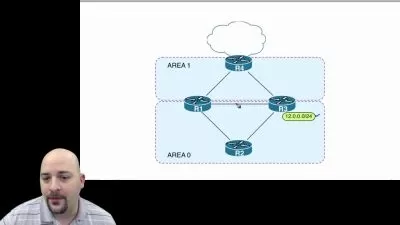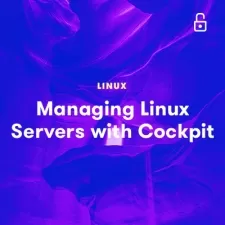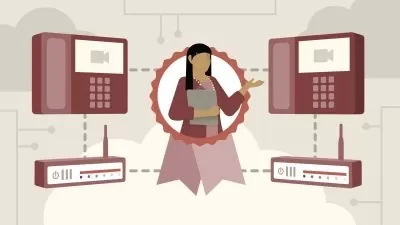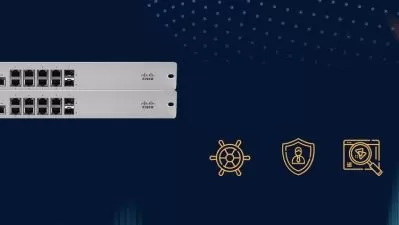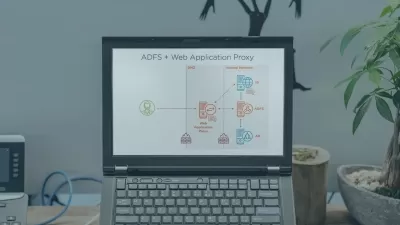1.Introducing Advanced OSPF on the JNCIP.mp4
02:41
2.OSPF Design Considerations.mp4
10:00
3.A (not so) Basic OSPF Deployment.mp4
15:00
4.OSPF Packet Types and LSAs.mp4
19:28
5.Verify LSDB Contents and Protect the LSDB.mp4
15:01
6.SPF Tuning.mp4
06:32
7.Metric Tuning.mp4
09:54
8.Rotating Authentication Keys.mp4
07:20
9.Summarizing Advanced OSPF Foundations.mp4
00:57
10.Introducing Advanced OSPF Configurations.mp4
01:28
11.OSPF Area Types.mp4
10:05
12.Route Summarization.mp4
14:01
13.Route Filtering.mp4
05:46
14.Multi-Area Single Adjacency.mp4
07:15
15.Virtual Links.mp4
09:13
16.Route Redistribution.mp4
12:07
17.Summarizing Advanced OSPF Configuration.mp4
00:53
18.Introducing Advanced IS-IS Foundation.mp4
02:56
19.Multi-Level IS-IS Refresher.mp4
17:44
20.IS-IS Packet Types.mp4
10:55
21.Basic Multi-Level IS-IS Deployment on JUNOS.mp4
14:38
22.LSPDU Contents and Common TLVs.mp4
08:42
23.delete-CBT.txt24.Metric Tuning.mp4
06:49
25.Validating IS-IS Config and LSDB.mp4
08:00
26.Hierarchical Authentication.mp4
05:52
27.Summarizing Advanced IS-IS Foundations.mp4
00:51
28.Introducing Advanced IS-IS Configurations.mp4
01:05
29.How the SPF Algorithm Works.mp4
11:47
30.The Partial SPF Run.mp4
03:52
31.Wide Metrics.mp4
08:42
32.The Overload Bit.mp4
04:17
33.Route Redistribution.mp4
08:51
34.Leak Routes from Level 2 to Level 1.mp4
06:14
35.Down Bit.mp4
04:23
36.Route Summarization.mp4
06:01
37.Summarizing Advanced IS-IS Config.mp4
00:51
38.Introducing BGP Foundations.mp4
02:20
39.The Point of BGP (Refreshed).mp4
15:12
40.BGP Messages.mp4
10:54
41.BGP Advertisement Rules.mp4
12:22
42.Next Hop Solutions in iBGP.mp4
06:47
43.A Basic BGP Config on Junos.mp4
22:56
44.BGP Best Path Selection Crash Course.mp4
08:28
45.BGP Authentication.mp4
05:52
46.Summarizing BGP Foundations.mp4
00:44
47.Introducing BGP Manipulation and Engineering.mp4
02:38
48.Configure GTSM.mp4
09:38
49.Dynamic Neighbor Adjacencies.mp4
06:17
50.BGP Database Protection.mp4
06:16
51.BGP Attribute Types.mp4
06:20
52.Configure Local Preference Policies.mp4
08:16
53.AS PATH Loops.mp4
08:29
54.AS Override.mp4
04:48
55.Remove Private ASs.mp4
06:09
56.AS PATH Prepend and Expand.mp4
06:27
57.Route Aggregation.mp4
06:09
58.Summarizing BGP Attributes.mp4
00:51
59.Introducing (more) Attribute Configurations.mp4
02:13
60.RegEx and AS Paths.mp4
11:21
61.Origin Code.mp4
05:53
62.MED (Multi-Exit Discriminator).mp4
08:08
63.BGP Communities Fundamentals.mp4
06:22
64.No Advertise Community.mp4
06:20
65.No Export (Subconfed) Community.mp4
06:47
66.Custom Communities for Grouping NLRIs.mp4
06:10
67.Summarizing Advanced BGP Manipulations.mp4
00:50
68.Introducing BGP Scaling.mp4
02:05
69.The Point of Route Reflectors.mp4
09:15
70.Configuring Route Reflectors on Junos.mp4
09:52
71.Design Full Mesh Core.mp4
06:12
72.Design Redundant Route Reflectors Within a Cluster.mp4
08:07
73.Design Hierarchical Route Reflectors.mp4
05:16
74.Design Full Mesh Cluster with Redundant Route Reflectors.mp4
06:18
75.Design Virtual Route Reflectors.mp4
05:43
76.Optimal Route Reflection (ORR).mp4
08:25
77.Confederations.mp4
05:52
78.Summarizing BGP Scale.mp4
01:01
79.Introducing FlowSpec.mp4
02:12
80.The Point of BGP FlowSpec (and DDoS Attacks).mp4
12:04
81.Prepare for BGP FlowSpec.mp4
11:59
82.CE Configure Flow Specification.mp4
08:26
83.CE Create and Export FlowSpec Policy.mp4
04:45
84.PE Create a Community.mp4
04:08
85.PE Create an Import Policy.mp4
08:36
86.Validate FlowSpec.mp4
05:50
87.Generating FlowSpecs Internally for Clients.mp4
13:40
88.Summarizing FlowSpec.mp4
01:50
89.Introducing BGP Route Damping.mp4
01:38
90.The Impact of Flapping Routes.mp4
13:47
91.Figures of Merit.mp4
11:37
92.Enable BGP Route Damping.mp4
05:38
93.Create Custom Damping Profiles.mp4
08:57
94.Create and Apply Damping Policies.mp4
07:50
95.Validate Route Damping.mp4
06:13
96.Summarizing BGP Route Damping.mp4
01:01
97.Introducing Multicast Routing.mp4
03:03
98.The Point of Multicast.mp4
10:08
99.Multicast Key Terms.mp4
14:34
100.Multicast Addressing (Layer 3 and Layer 2).mp4
11:27
101.IGMP.mp4
08:28
102.Dense Mode (and Source Trees).mp4
05:51
103.Sparse Mode (and Shared Trees).mp4
06:04
104.Unicast RPF Check.mp4
06:56
105.Summarizing Multicast Routing Fundamentals.mp4
01:04
106.Introducing Advanced Multicast Configurations.mp4
01:09
107.Deploy IGMP Snooping.mp4
06:40
108.Deploy PIM Dense Mode.mp4
10:04
109.Deploy PIM Sparse Mode.mp4
13:12
110.Deploy AutoRP.mp4
13:51
111.Deploy Bootstrap Router (BSR).mp4
06:21
112.Source-Specific Multicast (SSM).mp4
07:38
113.Summarizing Multicast Configurations.mp4
00:40
114.Introducing Class of Service.mp4
01:53
115.How CoS Works.mp4
17:26
116.A Closer Look at DSCP and Queueing.mp4
06:26
117.Create a CoS Classifier.mp4
07:35
118.Classifying Based on IP Header Fields.mp4
06:52
119.A Closer Look at Schedulers.mp4
09:48
120.Re-Write Rules.mp4
05:34
121.Drop Profiles.mp4
07:28
122.Policers.mp4
10:08
123.Summarizing CoS on Junos.mp4
01:03
124.Introducing Modern Data Center Designs.mp4
01:32
125.What IS a Data Center, Anyway.mp4
11:39
126.The Pros and Cons to the Traditional Design Model.mp4
13:57
127.Never Forget the Servers.mp4
05:33
128.The Evolution of Data Center Designs and Technologies - MC-LAG.mp4
06:34
129.Virtual Chassis and VCF.mp4
06:57
130.Junos Fusion.mp4
04:45
131.Todays Data Center - The Spine-Leaf Architecture.mp4
08:23
132.A Brief Intro to EVPN-VXLAN.mp4
07:27
133.Summarizing Data Center Designs and Foundations.mp4
01:01
134.Introducing ZTP in the Data Center.mp4
01:07
135.The Problem with Manually Scaling a Data Center.mp4
07:28
136.The Point of ZTP (and Automation in general).mp4
04:00
137.How ZTP Works.mp4
07:04
138.DHCP Options.mp4
08:47
139.Leveraging Junos Space with Network Director.mp4
06:56
140.Starting Over - Zeroize.mp4
06:46
141.ZTP and Automation Techniques.mp4
07:54
142.Summarizing ZTP.mp4
01:11
143.Introducing the Underlay Designs and Deployments.mp4
01:49
144.The Importance of the IP Fabric Underlay.mp4
09:30
145.IP Fabric Objectives.mp4
08:16
146.eBGP vs OSPF as an Underlay.mp4
09:43
147.OSPF Deployment.mp4
09:18
148.OSPF Validation.mp4
05:06
149.Enable Load Balancing on Junos.mp4
05:22
150.eBGP Deployment.mp4
11:02
151.eBGP Validation.mp4
04:14
152.Hardware Options.mp4
07:03
153.Oversubscription Models.mp4
07:39
154.Summarizing the IP Fabric Underlay.mp4
01:20
155.Introducing Juniper Hardware Deployment Options.mp4
03:23
156.Transceivers and Fiber.mp4
11:29
157.Fiber Standards.mp4
08:48
158.Fiber vs. Copper Cabling.mp4
09:18
159.Top of Rack Switches.mp4
03:44
160.The QFX5100-series Switch.mp4
10:13
161.The QFX-51xx Series Switches.mp4
08:33
162.The QFX-52xx Series Switches.mp4
03:52
163.The QFX-100xx Series Switches.mp4
05:13
164.Summarizing Juniper Data Center Hardware.mp4
00:55
165.Introducing Software in the Data Center.mp4
02:06
166.What is an API.mp4
15:20
167.Software-Defined Networking and Automation.mp4
10:43
168.Apstra.mp4
05:12
169.Reserve an Apstra vLab.mp4
09:32
170.Exploring Apstra in vLabs.mp4
09:11
171..Contrail.mp4
07:26
172.Ansible.mp4
10:24
173.PyEZ.mp4
06:03
174.Summarizing Software Defined Networking in Juniper Data Centers.mp4
00:49
175.Introducing Data Center Architecures.mp4
01:47
176.5 Factors for Data Center Planning.mp4
08:21
177.Where Spine-Leaf Fits In.mp4
07:01
178.Selecting an Underlay.mp4
07:01
179.Not Really Selecting an Overlay - EVPN.mp4
05:20
180.L3 Gateway Placement Spine Gateways.mp4
07:44
181.L3 Gateway Placement Edge Routed Gateways.mp4
04:46
182.L3 Gateway Placement Servers.mp4
04:31
183.Service Block Designs.mp4
07:22
184.Summarizing Data Center Architectures.mp4
01:22
185.Introducing Virtual Chassis and VCFs.mp4
01:35
186.Virtual Chassis and VCFs are for Even More Scalability.mp4
09:57
187.RE and PFEs in VCs and VCFs.mp4
08:25
188.Virtual Chassis (and VCF) Deployment Methods.mp4
08:44
189.Where VCF Differs from VC.mp4
06:21
190.Member Numbers and Interface Names.mp4
04:46
191.Traffic Flows in VCFs.mp4
07:06
192.Summarizing Virtual Chassis and VCFs.mp4
01:15
193.Introducing VXLAN.mp4
02:19
194.The Point of VXLAN.mp4
11:18
195.What About EVPN.mp4
07:45
196.VXLAN Key Terms.mp4
07:44
197.VXLAN Designs in Spine-Lead Architectures.mp4
06:42
198.Deciphering the VXLAN Packet.mp4
05:04
199.Layer 2 and Layer 3 Gateways.mp4
07:38
200.Controllerless VXLAN (aka Multicast VXLAN).mp4
05:51
201.Summarizing VXLAN Foundations.mp4
00:45
202.Introducing EVPN.mp4
01:53
203.Comparing EVPN to Multicast for a VXLAN Control Plane.mp4
09:29
204.EVPN Key Terms.mp4
05:59
205.EVPN Packet Types.mp4
14:11
206.The Type 2 NLRI.mp4
10:48
207.The Type 3 NLRI.mp4
04:50
208.The Type 4 NLRI.mp4
06:59
209.The Type 1 ESI NLRI.mp4
06:02
210.The Type 1 EVI NLRI.mp4
05:13
212.Introducing EVPN-VXLAN Deployment on Junos.mp4
02:28
213.The Plan of Attack.mp4
11:05
214.Setting Up Some Global Parameters.mp4
10:03
215.Configure the Underlay (eBGP).mp4
09:59
216.Configure the Overlay (iBGP).mp4
08:37
217.Create VLANs and VNIs.mp4
05:17
218.Create the Anycast Gateway.mp4
07:34
219.Configure EVPN.mp4
04:23
220.Configure VXLAN.mp4
07:41
221Verify EVPN-VXLAN.mp4
04:10
222.Summarizing EVPN-VXLAN Configuration on Junos.mp4
01:15
223.Introducing EVPN-VXLAN Validation and Troubleshooting.mp4
02:26
224.Explore the Route Tables.mp4
14:08
225.The Type 2 NLRI.mp4
09:46
226.The Type 3 NLRI.mp4
04:38
227.The Type 4 NLRI.mp4
05:46
228.The Type 1 ESI NLRI.mp4
05:36
229.The Type 1 EVI NLRI.mp4
04:06
230.Validating Layer 3 Details.mp4
06:53
231.Validating Participating Interface Details.mp4
06:34
232.Validating VXLAN.mp4
05:54
233.Summarizing EVPN-VXLAN Validation and Troubleshooting.mp4
00:55
234.Introducing EVPN Multicast Strategies.mp4
01:31
235.Multicast and EVPN Refresher.mp4
08:08
236.The Role IGMP Plays in EVPN.mp4
05:07
237.The Multicast NLRIs.mp4
07:43
238.The Type 6 NLRI.mp4
04:39
239.The Type 7 NLRI.mp4
07:58
240.The Type 8 NLRI.mp4
04:34
241.Designated Router Challenges.mp4
04:12
242.EVPN Multicast Configuration.mp4
09:14
243.Summarizing EVPN Multicast.mp4
01:03
244.Introducing MC-LAG in the Data Center.mp4
01:35
245.The Plan of Attack.mp4
08:58
246.Deploy the Server-Side LAGG.mp4
06:50
247.Deploy the ICL.mp4
06:57
248.Deploy ICCP.mp4
07:18
249.Deploy Active-Standby MC-LAG.mp4
09:30
250.Validate the Configuration.mp4
04:03
251.Deploy Active-Active MC-LAG.mp4
05:37
252.Integrate with EVPN-VXLAN.mp4
04:30
253.Summarizing MC-LAG in the Data Center.mp4
00:57
254.Introducing DCI Concepts.mp4
01:51
255.The Point of DCI.mp4
06:19
256.Layer 2 Stretching.mp4
04:39
257.Layer 2 and Layer 3 Across an IP WAN.mp4
07:55
258.Layer 3 DCI Across MPLS L3VPN.mp4
07:32
259.Layer 2 & 3 DCI Across VPLS or EVPN.mp4
07:08
260.Point-to-Point DCIs.mp4
05:18
261.A Closer Look at Handoff Options in P2P DCIs.mp4
06:06
262.Summarizing DCI Concepts.mp4
01:02
263.Introducing DCI Deployment on Junos.mp4
02:00
264.Understanding the Lab Strategy and Setup.mp4
16:04
265.The eBGP Relationships.mp4
13:02
266.The iBGP Relationships.mp4
06:06
267.A Careful Examination of VRFs - the Layer 3 VRF.mp4
10:28
268.The Layer 2 Routing Instance.mp4
09:51
269.Validating the Configuration.mp4
06:04
270.The Type-5-Only DCI.mp4
05:01
271.Summarizing DCI Configuration.mp4
00:56
272.Introducing DCI Traffic Flow Design Considerations.mp4
01:49
273.DCI Traffic Flows in the Real World.mp4
08:18
274.Pods and Super Spines.mp4
09:02
275.Refreshing the Service Block Designs.mp4
05:33
276.Intra-VRF Traffic Flows.mp4
09:00
277.Inter-VRF Traffic Flows.mp4
08:07
278.Internet-Bound Traffic Flows.mp4
05:31
279.Summarizing DCI Traffic Flow Designs.mp4
01:33







